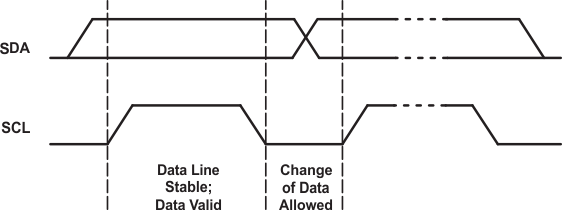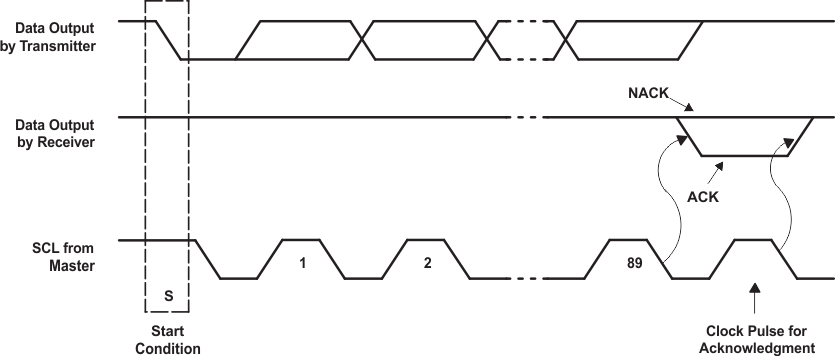ZHCSIO3I January 2005 – August 2024 PCF8575
PRODUCTION DATA
- 1
- 1 特性
- 2 应用
- 3 说明
- 4 Pin Configuration and Functions
- 5 Specifications
- 6 Typical Characteristics
- 7 Parameter Measurement Information
- 8 Detailed Description
- 9 Application and Implementation
- 10Device and Documentation Support
- 11Revision History
- 12Mechanical, Packaging, and Orderable Information
封装选项
机械数据 (封装 | 引脚)
散热焊盘机械数据 (封装 | 引脚)
- RGE|24
订购信息
8.3.1 I2C Interface
The bidirectional I2C bus consists of the serial clock (SCL) and serial data (SDA) lines. Both lines must be connected to a positive supply via a pullup resistor when connected to the output stages of a device. Data transfer may be initiated only when the bus is not busy.
I2C communication with this device is initiated by a controller sending a Start condition, a high-to-low transition on the SDA input/output while the SCL input is high (see Figure 8-3). After the Start condition, the device address byte is sent, most significant bit (MSB) first, including the data direction bit (R/ W). This device does not respond to the general call address. After receiving the valid address byte, this device responds with an ACK, a low on the SDA input/output during the high of the ACK-related clock pulse. The address inputs (A2–A0) of the target device must not be changed between the Start and Stop conditions.
The data byte follows the address ACK. If the R/ W bit is high, the data from this device are the values read from the P port. If the R/ W bit is low, the data are from the controller, to be output to the P port. The data byte is followed by an ACK sent from this device. If other data bytes are sent from the controller, following the ACK, they are ignored by this device. Data are output only if complete bytes are received and acknowledged. The output data is valid at time (tpv) after the low-to-high transition of SCL, during the clock cycle for the ACK.
On the I2C bus, only one data bit is transferred during each clock pulse. The data on the SDA line must remain stable during the high pulse of the clock period, as changes in the data line at this time are interpreted as control commands (Start or Stop) (see Figure 8-4).
A Stop condition, a low-to-high transition on the SDA input/output while the SCL input is high, is sent by the controller (see Figure 8-3).
The number of data bytes transferred between the Start and Stop conditions from transmitter to receiver is not limited. Each byte of eight bits is followed by one ACK bit. The transmitter must release the SDA line before the receiver can send an ACK bit.
A target receiver that is addressed must generate an ACK after the reception of each byte. Also, a controller must generate an ACK after the reception of each byte that has been clocked out of the target transmitter. The device that acknowledges has to pull down the SDA line during the ACK clock pulse so that the SDA line is stable low during the high pulse of the ACK-related clock period (see Figure 8-5). Setup and hold times must be taken into account.
A controller receiver must signal an end of data to the transmitter by not generating an acknowledge (NACK) after the last byte that has been clocked out of the target. This is done by the controller receiver by holding the SDA line high. In this event, the transmitter must release the data line to enable the controller to generate a Stop condition.
 Figure 8-3 Definition of Start and Stop Conditions
Figure 8-3 Definition of Start and Stop Conditions Figure 8-4 Bit Transfer
Figure 8-4 Bit Transfer Figure 8-5 Acknowledgment on I2C Bus
Figure 8-5 Acknowledgment on I2C Bus